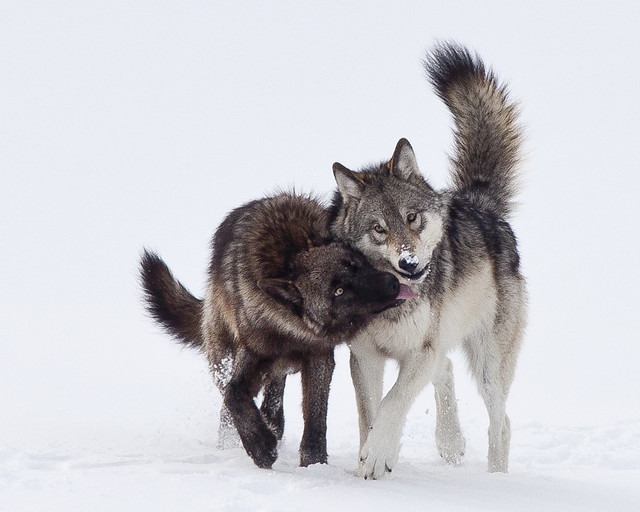
Minus-31 degrees at Cooke City and minus-24 at the Lamar
Valley? Yes, we told the incoming group of 17 for the Greater
Yellowstone Coalition’s annual winter wildlife-watching trip, but it’s a
dry minus-31.
Thankfully, the group was prepared. Two guests from Tucson, Ariz., could’ve been mistaken for two-legged bison as they trudged in the early morning darkness down a snow-covered path at the Buffalo Ranch. Each wore enough layers to clothe an Inuit village. One had a fur cap the size of Delaware.
Thankfully, the group was prepared. Two guests from Tucson, Ariz., could’ve been mistaken for two-legged bison as they trudged in the early morning darkness down a snow-covered path at the Buffalo Ranch. Each wore enough layers to clothe an Inuit village. One had a fur cap the size of Delaware.
Wildlife watching in January in Yellowstone National Park is at
once exhilarating and challenging, rewarding and a test of intestinal
fortitude. There’s a reason the lone open road is so empty, save for the
periodic whoosh of a half-ton hauling snowmobiles and crawl of an SUV
bearing the telltale antennae of wolf watchers.
Scanning the snow-crusted hillsides for wolves means standing
in an icy place for long periods, shifting from foot to foot on
heat-retaining blue mats. Fingers and toes go cold, even with warmers
tucked inside mittens and boots.
So why all the fuss? This: A woman from Virginia named Melissa
raises her voice from the back of the bus. She is slightly apprehensive.
After all, she has seen wolves become boulders – Canis minerales – amid
such excitement before.
And yet ... more than a dozen ravens were circling, flitting
and hopping in a familiar dance. To the trained park eye, this is a sure
sign they are on a carcass. And a carcass means wolves.
“I see movement!” she finally exclaims. “I see ravens. I see eagles. I think I see ... three wolves!”
The bus pulls into the parking lot at the Slough Creek turnoff.
We have the place to ourselves. The group scans the distant hillside
near an old wolf den.
Sure enough, far in the distance, too far for the naked eye,
three black wolves are on an elk carcass. Bald eagles waited in nearby
conifers. A dozen or so remaining cow elk and calves, the danger over,
lay bedded on a snowy hill just above the kill, all eyes trained on the
scene.
One by one, scopes on tripods are anchored in the snow, and the
reason we’re all here unfolds in front of our eyes: Eight members of
the new Junction Butte pack are in full display.
The emotional uplift is palpable. Energy soars. Chatter quickens.
Until now, questions about the status of Yellowstone’s wolves
dominated the conversation. Though numbers are holding steady at between
70-80 in the park, the loss of collared wolves, killed legally by
hunters outside the park, has thrown the species into disarray.
Three frequently visible Lamar Canyon wolves were off in the
backcountry, trying to find order after the death of their alpha female,
the famous 832F, in Wyoming. The whereabouts of the new Junction Butte
Pack, formed by a liaison between the Mollie’s and the Blacktails in
2012, has been uncertain because a hunter in Montana shot the only
collared wolf.
The Blacktails are down to a small handful. The Agates are gone
altogether, the victims of one-by-one takings by the more-powerful
Mollie’s, which had migrated northwest to the Lamar Valley from their
usual home in the Pelican Valley.
Would we see wolves? For the first time on one of our wildlife trips, nobody could say with any real certainty.
Now here they were, the pack without collars, in plain view. It is an extraordinary moment, a stroke of pure good fortune.
Seeing them was an important reminder that wolves are a
marvelous conservation success story. Concerns that we might not is also
a reminder of the need for the states adjoining Yellowstone to adjust
hunting and trapping rules next year to give park wolves higher
protections.
Yellowstone’s wolves are critical to a healthy ecology. They
are an important research tool. They also give tens of thousands of
visitors a reason to come to Yellowstone – even when it’s minus-31
degrees and enduring the dry cold requires dressing like a two-legged
bison.
Jeff Welsch is communications director for the Greater Yellowstone Coalition. He can be reached at jwelsch@greateryellowstone.org.
source
source

No comments:
Post a Comment